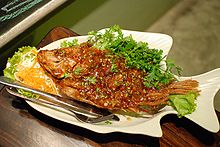- Oreochromis niloticus
-
Nile Tilapia 
Male, Democratic Republic of Congo Scientific classification Kingdom: Animalia Phylum: Chordata Class: Actinopterygii Order: Perciformes Family: Cichlidae Genus: Oreochromis Species: O. niloticus Binomial name Oreochromis niloticus
(Linnaeus, 1758)The Nile Tilapia, Oreochromis niloticus is a relatively large cichlid fish, which is native to Africa from Egypt south to East and Central Africa, and as far west as Gambia. It is also native to Israel, and numerous introduced populations exist outside its natural range.
It is also commercially known as Mango fish or Nilotica.[1][not in citation given] The first name leads to easy confusion with another tilapia that is traded commercially, the Mango tilapia (Sarotherodon galilaeus).
Description
Variously reported in the literature to be a plankton feeder, an omnivore, and to feed on higher plants to the extent that it may be used in control of aquatic weeds.
Introduced tilapias can, on the other hand, easily become an invasive species (see Tilapia as exotic species).
It is a species of high economic value and is widely introduced outside its natural range; probably next to the Mozambique tilapia (O. mossambicus) it is the most commonly cultured cichlid.[citation needed]
Aquaculture
Aquaculture of the Nile tilapia goes back to Ancient Egypt, where it was called ỉn.t and represented by hieroglyph K1 of the Gardiner List. As a logogram, this meant "a Nile tilapia". Used as a determinative (ideogram), it apparently signified Nile tilapia and/or flathead mullets which like the tilapia were commercially important fish, namely in the Nile delta:


If used as part of a phonogram, it represented the sound ỉn:

In modern aquaculture, wild-type Nile tilapia are not too often seen, as their flesh has a dark color that is not much desired by many customers, and because it has a bit of a reputation of being a trash fish associated with poverty[2]. On the other hand, they are fast-growing and give good fillets; leucistic ("Red") breeds which have lighter meat have been developed and these are very popular.
Hybrid stock is also used in aquaculture; Nile × Blue Tilapia hybrids are usually rather dark, but a light-colored hybrid breed known as "Rocky Mountain White" tilapia is often grown due to its very light flesh and tolerance of low temperatures.[2]
The Nile Tilapia has recently been discovered in a small stream in central Arkansas. This invasive species may harm the other aquatic life present in this stream within the next few years, depending on how quickly it is able to reproduce and how adapted it is to competition with other aquatic vertebrates. As of yet, there is evidence to support the possibility that the Nile Tilapia has established a strong breeding ground and will eventually endanger other fish species, possibly competitively exclude them.
Gastronomy
Pla thapthim thot samrot: deep fried 3 flavours Tilapia
The red-hybrid Oreochromis niloticus is known in Thai language as Pla Thapthim (Thai: ปลาทับทิม), meaning "pomegranate fish".[3] This type of Tilapia is very popular in Thai cuisine where it is prepared in a variety of ways.[4]
The white tilapia Pla nin (Thai: ปลานิล), meaning "Nile fish", is commonly either salted and barbecued or steamed with lime (pla nin nueng manao).[5]
Systematics
- Baringo tilapia, Oreochromis niloticus baringoensis Trewavas, 1983
- Oreochromis niloticus cancellatus[verification needed] (Nichols, 1923)
- Oreochromis niloticus eduardianus[verification needed] (Boulenger, 1912)
- Oreochromis niloticus filoa Trewavas, 1983
- Oreochromis niloticus niloticus (Linnaeus, 1758)
- Oreochromis niloticus sugutae Trewavas, 1983
- Oreochromis niloticus tana Seyoum & Kornfield, 1992
- Oreochromis niloticus vulcani[6] (Trewavas, 1933)
The forms referred to as Oreochromis (or Tilapia) "Nyabikere" and "Kabagole" seem to belong to this species too. An undescribed[verification needed] population found at, for example, Wami River, Lake Manyara and Tingaylanda seems to be a close relative.(Nagl et al. 2001)
Medical significance
In a recent research in Kenya, it has been suggested that as this fish can feed on mosquito larvae, it could be used in the fight against malaria in Africa.[7]
See also
- Nile perch - a different fish, more common today as "Victoria perch". Both this fish and the Nile tilapia belong to the Perciformes, or perch-like fish.
References
- Froese, Rainer, and Daniel Pauly, eds. (2005). "Oreochromis niloticus" in FishBase. November 2005 version.
- "Oreochromis niloticus". Integrated Taxonomic Information System. http://www.itis.gov/servlet/SingleRpt/SingleRpt?search_topic=TSN&search_value=553310. Retrieved 11 March 2006.
- Bardach, J.E.; Ryther, J.H. & McLarney, W.O. (1972): Aquaculture. the Farming and Husbandry of Freshwater and Marine Organisms. John Wiley & Sons.
- Nagl, Sandra; Tichy, Herbert; Mayer, Werner E.; Samonte, Irene E.; McAndrew, Brendan J. & Klein, Jan (2001): Classification and Phylogenetic Relationships of African Tilapiine Fishes Inferred from Mitochondrial DNA Sequences. Molecular Phylogenetics and Evolution 20(3): 361–374. doi:10.1006/mpev.2001.0979
- ^ Nile Tilapia. Seafood Portal.
- ^ [1]
- ^ Management Guidelines of Red Tilapia Culture in Cages, Trang Province (Thai)
- ^ Recipes for Thaptim Fish
- ^ Fish breeding in Thailand
- ^ Kingdon, Jonathan (1989). Island Africa: The Evolution of Africa's Rare Plants and Animals. Princeton, New Jersey: Princeton University Press. pp. 221–222. ISBN 0-691-08560-9.
- ^ "Nile Tilapia can fight malaria mosquitoes", BBC News 8th August 2007.
Categories:- Oreochromis
- Thai ingredients
- Animals described in 1758
Wikimedia Foundation. 2010.


